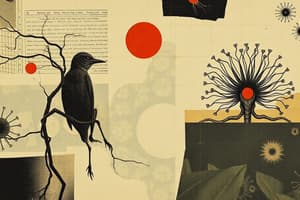Podcast
Questions and Answers
A species of beetle reproduces asexually. What would be the most likely result of this reproductive strategy?
A species of beetle reproduces asexually. What would be the most likely result of this reproductive strategy?
- Increased genetic diversity, allowing for rapid adaptation to changing environments.
- A greater number of offspring with random mutations, ensuring some survive environmental changes.
- Decreased genetic variation, potentially making the population vulnerable to new diseases. (correct)
- Offspring with a combination of traits from two different parent beetles.
During which specific phase of the cell cycle does DNA replication occur, ensuring that each daughter cell receives a complete set of genetic information?
During which specific phase of the cell cycle does DNA replication occur, ensuring that each daughter cell receives a complete set of genetic information?
- Prophase of Mitosis
- Telophase of Meiosis II
- Cytokinesis
- S phase of Interphase (correct)
A cell with 46 chromosomes undergoes mitosis. How many chromosomes will each of the resulting daughter cells have?
A cell with 46 chromosomes undergoes mitosis. How many chromosomes will each of the resulting daughter cells have?
- 46 (correct)
- 92
- 11.5
- 23
What is the primary purpose of meiosis in sexually reproducing organisms?
What is the primary purpose of meiosis in sexually reproducing organisms?
Which of the following sequences accurately represents the order of events in sexual reproduction?
Which of the following sequences accurately represents the order of events in sexual reproduction?
If a zygote contains 78 chromosomes, how many chromosomes did each gamete contribute?
If a zygote contains 78 chromosomes, how many chromosomes did each gamete contribute?
What is the main role of the placenta during pregnancy?
What is the main role of the placenta during pregnancy?
Which event is directly triggered by hormones released by the ovaries and brain during the menstrual cycle?
Which event is directly triggered by hormones released by the ovaries and brain during the menstrual cycle?
Flashcards
Asexual Reproduction
Asexual Reproduction
Offspring are genetically identical to the parent; involves only one parent.
Sexual Reproduction
Sexual Reproduction
Offspring are genetically different from parents; involves two parents.
Mitosis
Mitosis
One cell divides into two; original and daughter cells are diploid (2n).
Meiosis
Meiosis
Signup and view all the flashcards
Ovaries
Ovaries
Signup and view all the flashcards
Testes
Testes
Signup and view all the flashcards
Fertilization
Fertilization
Signup and view all the flashcards
Sexual Reproduction Stages
Sexual Reproduction Stages
Signup and view all the flashcards
Study Notes
- Asexual reproduction results in offspring genetically identical to a single parent.
- In asexual reproduction one creature splits into two with little to no genetic variation.
- Sexual reproduction yields offspring with genetic differences from both parents.
- Sexual reproduction involves two parents combining genetic information.
- Sexual reproduction results in substantial genetic variation.
- Sexual reproduction offspring inherit 50% of their genetic information from each parent.
- DNA replication happens during interphase (S phase), before cell division in mitosis and meiosis.
- Mitosis involves one cell dividing into two cells.
- Daughter cells and the original cell in Mitosis are diploid (2n).
- Meiosis is when one parent cell divides into four cells.
- In meiosis the parent cell is diploid (2n) while daughter cells are haploid (n).
- Crossing over occurs during meiosis which leads to variation in sexual reproduction.
- As a result of meiosis, each gamete possesses a unique combination of genes.
- Ovaries produce female sex cells (eggs).
- Testes produce male sex cells (sperm).
- Fertilization, exclusively in sexual reproduction results in gametes joining to form a zygote (fertilized egg).
- Hormones regulate gamete production and related processes in both males and females.
- Somatic cells in humans have 46 chromosomes (23 pairs).
- Each species has a specific and unique amount of chromosomes in their cells.
- Sexual reproduction stages: meiosis (gamete production), fertilization, mitosis (growth), differentiation, and birth.
- Stages of human development: gametes → zygote → embryo → fetus → baby.
- The female menstrual cycle takes about 28 days.
- Menstruation (shedding of the uterine lining) and ovulation (egg release) occur during the menstrual cycle.
- Hormones from the ovaries and the brain control the menstrual cycle.
Female Reproductive System Organs
- Ovaries, fallopian tubes (oviduct), uterus, cervix, and vagina are major components.
Female Reproductive System Organs Specifically During Pregnancy
- Placenta, umbilical cord, amniotic sac are major components during pregnancy.
Male Reproductive System Organs
- Testes, vas deferens, urethra, penis, and scrotum are major components.
Studying That Suits You
Use AI to generate personalized quizzes and flashcards to suit your learning preferences.
Description
Explore asexual reproduction, producing genetically identical offspring from one parent. Contrast this with sexual reproduction, where two parents create offspring with genetic variation. Understand DNA replication, mitosis (one cell to two diploid cells), and meiosis (one diploid cell to four haploid cells with crossing over).




